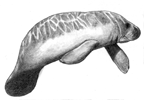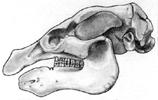Manatees Eating Habits
Manatees keep canals and other bodies of water
free from over growth of these rapidly growing waterplants
that would quickly cover a body of water making it nearly
impossible for other animals to survive. The manatee are
actually very useful in keeping canals and waterways free
from over growth, even boaters appreciate a clear stretch of
water free from waterplants.

Diet Preferences
 Florida
Manatees feed on over 60 species of submerged, floating, and
shoreline vegetation plants. These include turtle grass,
manatee grass, shoal grass, mangrove leaves, various algae,
water hyacinth, and water hydrilla.
Florida
Manatees feed on over 60 species of submerged, floating, and
shoreline vegetation plants. These include turtle grass,
manatee grass, shoal grass, mangrove leaves, various algae,
water hyacinth, and water hydrilla.
Manatees avoid specific plants, such as spatterdock and waterpennywort, that contain natural toxin.
Manatees consume about 4% to 9% (32 to 108 lb. for an adult manatee) of their body weight in wet vegetation every day.

Methods of feeding 
Manatees feed off the bottom, in the water column, and at the surface. They have even been known to crop overhanging branches, consume acorns, and haul themselves partially out of the water to eat bank vegetation.
Manatees use their front flippers and large, flexible lips to manipulate vegetation.
Ridged pads at the front of a manatee's mouth and
lower jaw break the vegetation into smaller pieces. Behind these
ridged pads, are molars that grind the food.
 A manatee has
24 to 32 molars located in the back of the mouth. The front
molars in each row are worn down by the abrasive plants that
the manatee eats. As the teeth wear down, new molars grow in
the back of the mouth and move forward. This process of
replacement continues throughout the manatees life providing
a new chewing surface as the teeth wear down.
A manatee has
24 to 32 molars located in the back of the mouth. The front
molars in each row are worn down by the abrasive plants that
the manatee eats. As the teeth wear down, new molars grow in
the back of the mouth and move forward. This process of
replacement continues throughout the manatees life providing
a new chewing surface as the teeth wear down.